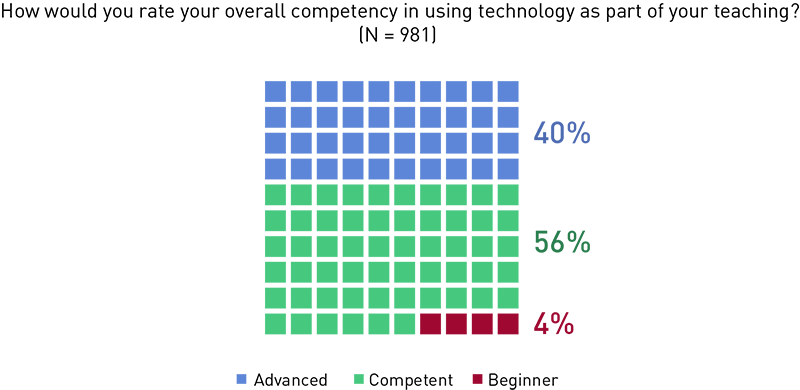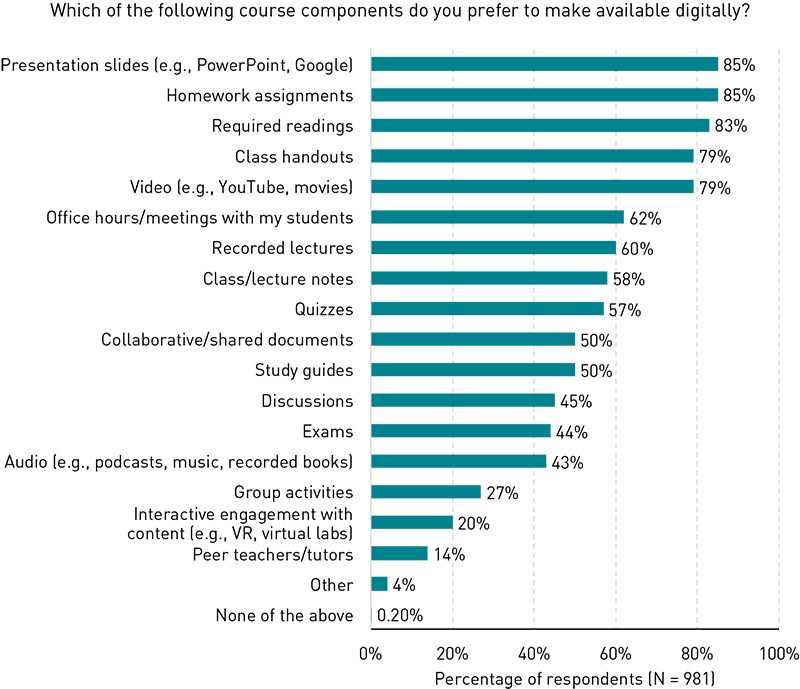Technology Experiences and Digital Access to Course Components
Faculty experiences with technology aren't the driving force behind modality preferences. Given that during the pandemic many institutions increased their adoption of instructional technology and online and hybrid courses, we asked faculty about their competency level and experiences with technology to determine whether these influence modality preferences and teaching experiences. A large majority of faculty felt competent or advanced using technology as part of their teaching (96%) (see figure 14).

We also asked faculty how their experiences with specific technologies have impacted their modality preferences. Most of the comments highlight positive aspects of using technology for teaching, with many responses indicating that technology helps make learning more available and flexible while also improving faculty efficiency and workload. Although faculty are largely positive about their use of technology for teaching, technology experiences don't seem to be largely driving their modality preferences. Rather, the use of technology seems to be commonplace and helpful in a number of ways, regardless of modality.
I have used Google Meet and Google Classroom onsite and online. The main reason I don't prefer teaching online is not the technology but the workload and student engagement.
A small portion of respondents did specifically indicate that their experiences have impacted their modality preferences. Of these, positive experiences with technology increase the preference to teach online courses.
I've taught online through Zoom and am quite experienced with it. I've used a variety of textbooks and other vendor sites (Connect, Mastering, Lrnr, SimBio, Labster, etc.). The more I knew about the technologies available, the more willing I was to embrace online teaching. I also use Respondus lockdown browser and monitor and Turnitin or SafeAssign to help with academic honesty in my classes.
I'm sure being competent with technology and using it in my classroom helps strengthen my desire to teach online because my students are engaged. If they were not I would probably prefer to go back to F2F classes.
Once I became comfortable/proficient with Zoom, I found it much more productive to teach online...having exams and assignments online also freed up class time, allowed me to be more flexible with students in submitting assignments, and lessened my out of class workload.
Regardless of modality, faculty put many components of their courses online. From a list of 18 course components, faculty identified those that they prefer to make digitally available to students. A majority prefer to make at least some aspects digital: less than 1% selected "none of the above" (see figure 15). Of the 18 components listed, 11 were selected by 50% or more of faculty. The three that were selected the least were ones that involved more interactivity and would thus likely be more difficult to implement online: group activities (27%), engagement with interactive content (e.g., VR, extended reality) (20%), and peer teachers/tutors (14%). We asked faculty what factors influence their decisions about how and when to make course components available digitally to students. Open-ended comments revealed a variety of factors, many of which surrounded consideration of student needs and preferences. Some of the reasons they gave for making decisions about digital availability include:
- Modality requirements that some things be shared digitally
- Helps facilitate class sessions (e.g., students review material digitally beforehand)
- Helps with class prep (e.g., ease of copying course materials)
- Difficulty/ease in making components digitally available
- Environmental concerns (reduction in paper waste)
- Consideration for what best facilitates learning and benefits students
- Accessibility and equity; implementation of UDL principles
- Provides flexibility for students
- Affordability (i.e., lower student costs)
- Student preference
- Convenience and ease
- Concerns over academic dishonesty

Overall, faculty were largely in favor of making course components digitally available. Yet some noted that there are instances in which they prefer components to be printed and/or available only on-site, and others said that making course components available digitally is not necessarily up to them.
I can't say that I "prefer" to have these things online; I am *required* to because of the hybrid or online modality.
When my students are on a screen in class—including to access online readings—they are more distracted and less engaged. I've moved away from screens in my classes.
I've exclusively taught online since the pandemic. I'm returning to in-person next academic year. At that time, I plan to put as much as possible online to reduce copying and grading time. In that way, I can focus more on delivering quality lessons and less time on paperwork. In other words, my workload is the biggest deciding factor. That said, I think [students] also benefit from using hard copies. As such, I have required a textbook. Toggling on screens can require a heavy cognitive load, particularly with distractions. A textbook can be a great skeleton for class.